Abstract
One hundred clinical isolates resistant to ceftazidime and/or cefotaxime were examined for susceptibility to cefepime. The most frequently encountered ceftazidime-cefotaxime-resistant strains belonged to the genera Enterobacter, Pseudomonas, and Citrobacter. Among these strains, 92% were resistant to cefoperazone, 91% were resistant to cefotaxime, 84% were resistant to ceftazidime, and 6% were resistant to cefepime. Of the members of the family Enterobacteriaceae, 57% were resistant to ceftriaxone. The six strains resistant to cefepime were all Pseudomonas aeruginosa and were resistant to both cefotaxime and ceftazidime. Cefepime-resistant P. aeruginosa strains had exceptionally high levels of beta-lactamase activity, higher than the levels found in strains resistant to ceftazidime but susceptible to cefepime. The beta-lactamases from the cefepime-resistant strains were type I (Richmond-Sykes), were constitutively produced, and did not have increased affinity or hydrolytic activity for cefepime. Thus, cefepime was active against most gram-negative bacteria which have developed resistance to the broad-spectrum cephalosporins, and resistance to cefepime in P. aeruginosa appears to be associated with higher beta-lactamase levels than in cefepime-susceptible strains.
Full text
PDF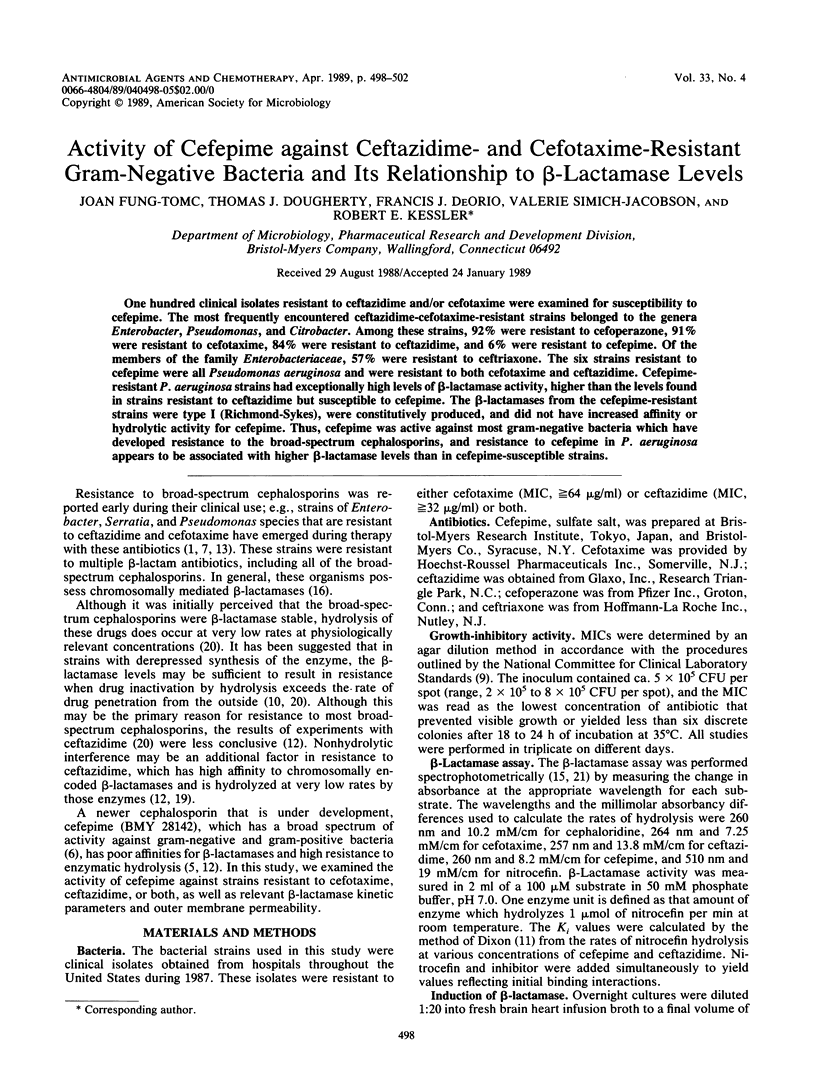
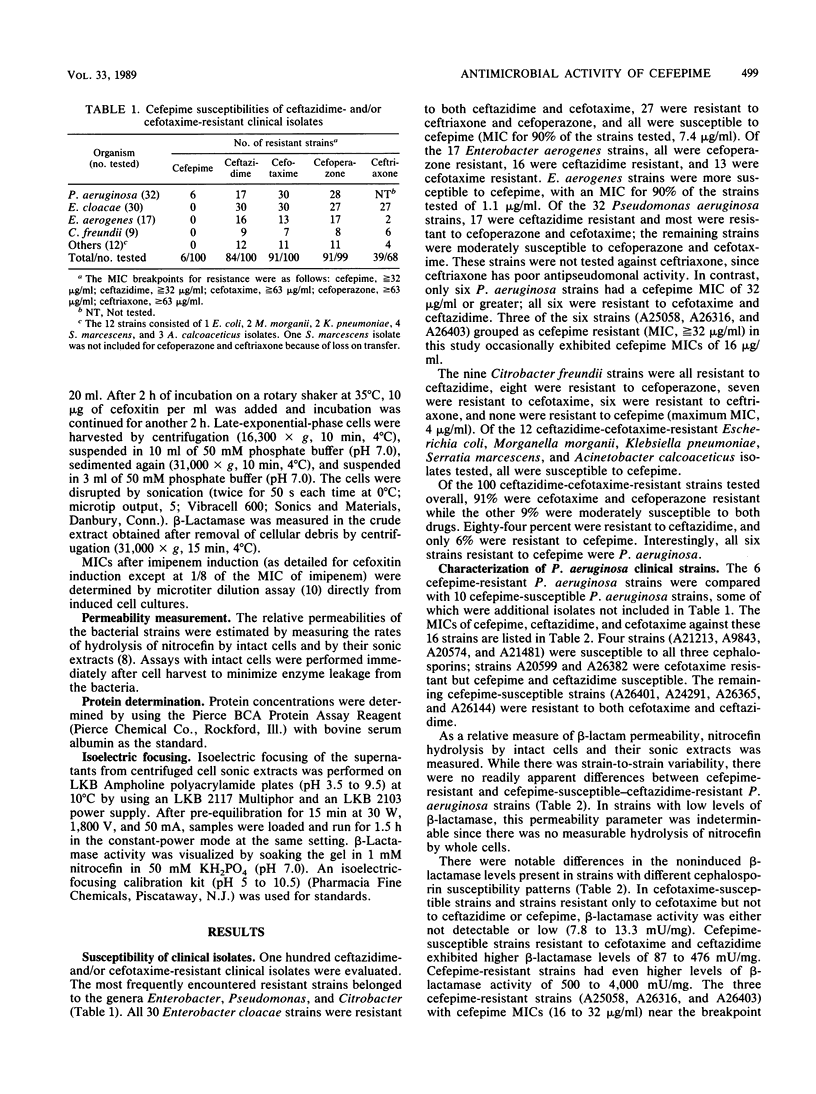
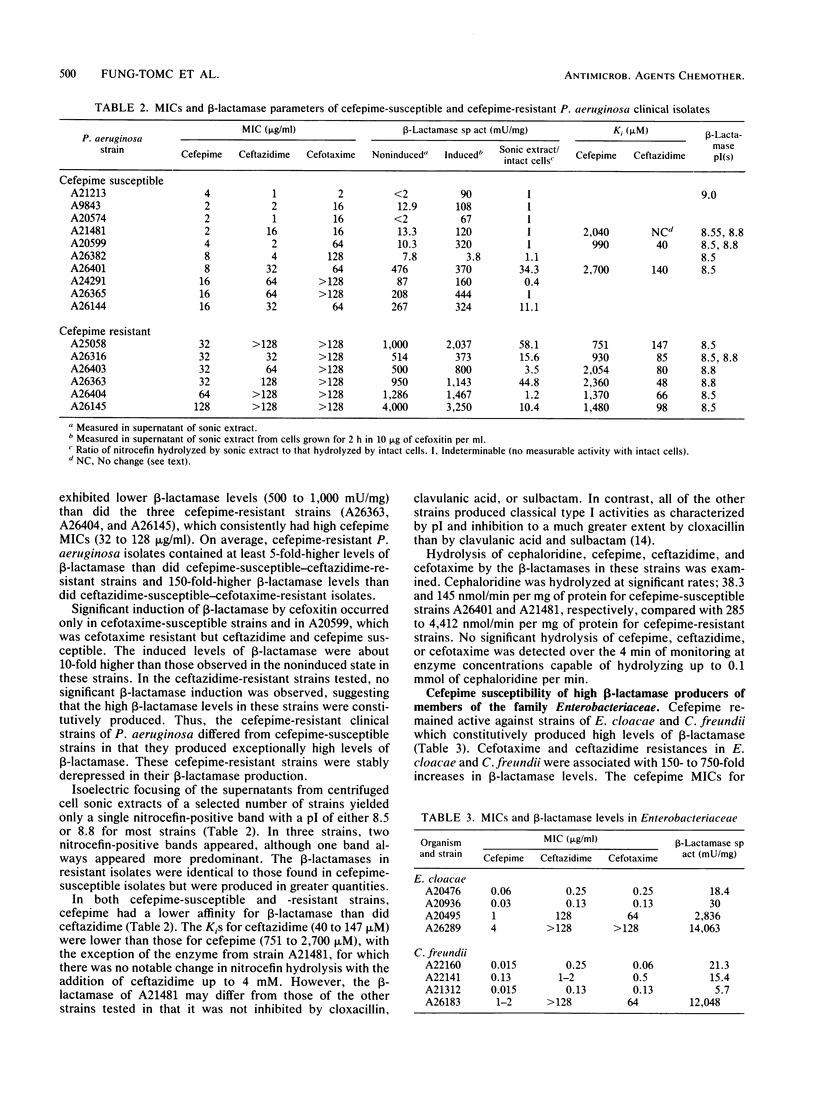
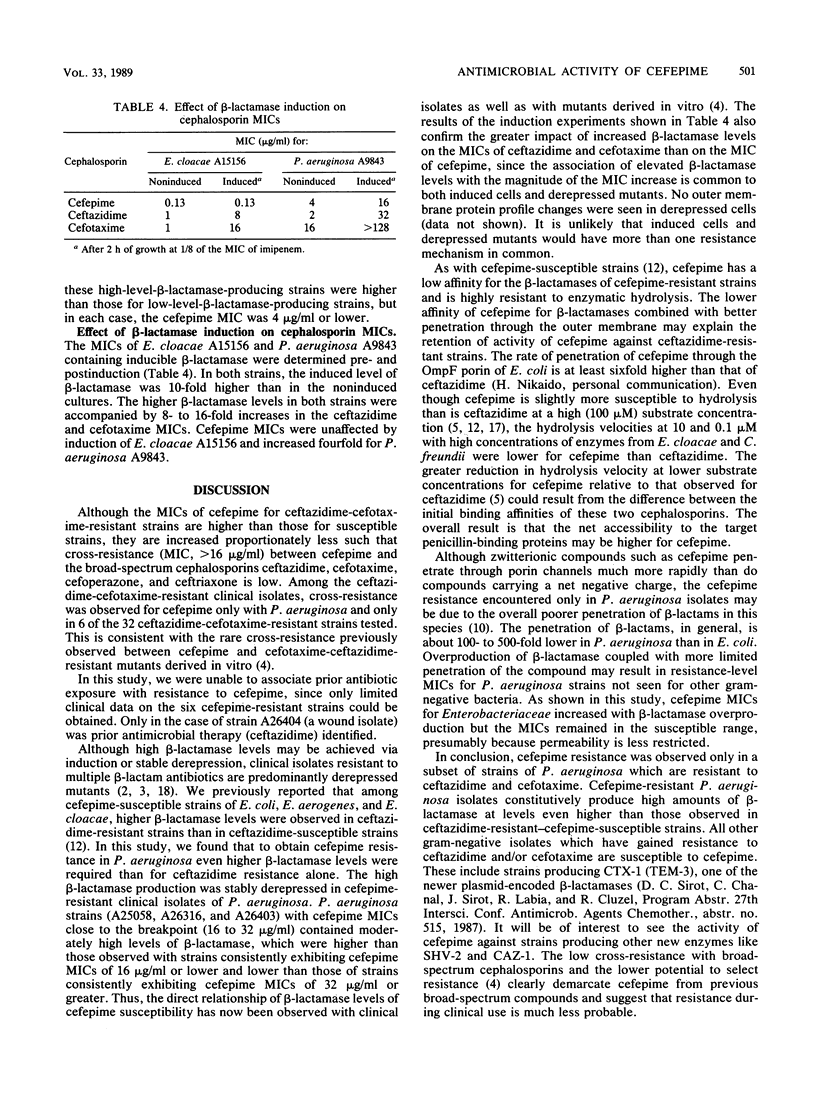
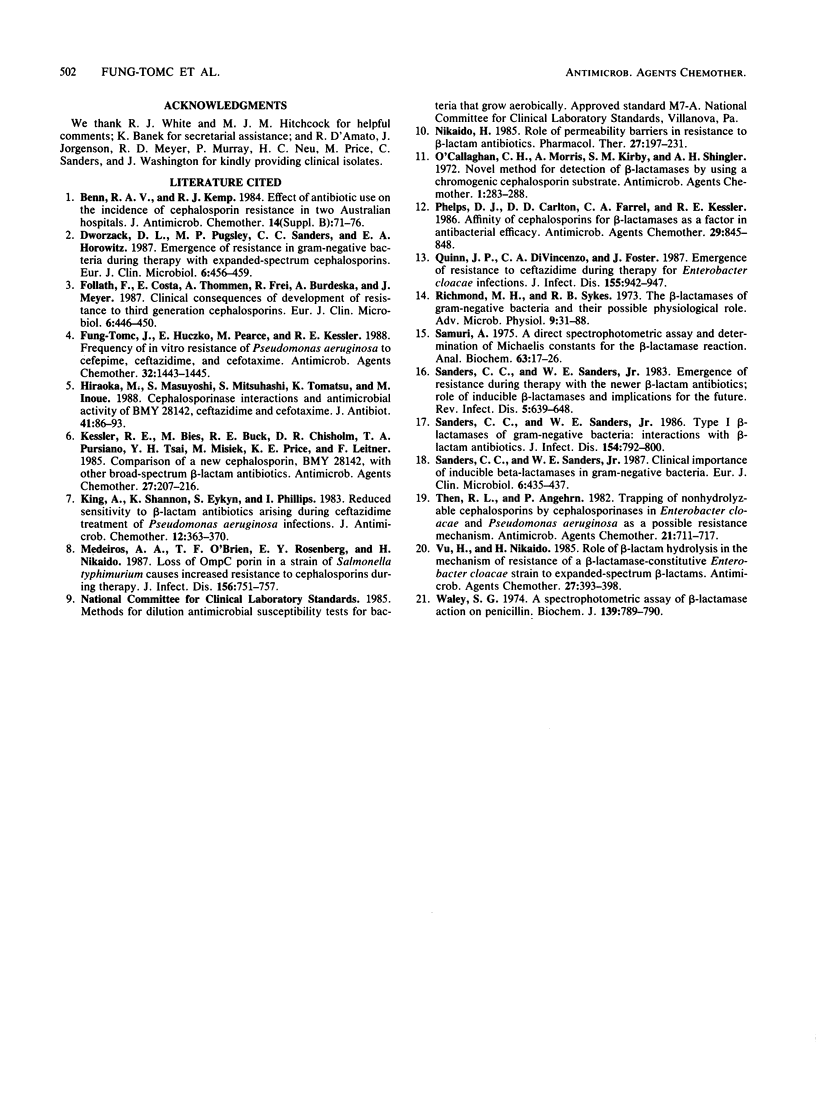
Selected References
These references are in PubMed. This may not be the complete list of references from this article.
- Benn R. A., Kemp R. J. Effect of antibiotic use on the incidence of cephalosporin resistance in two Australian hospitals. J Antimicrob Chemother. 1984 Sep;14 (Suppl B):71–76. doi: 10.1093/jac/14.suppl_b.71. [DOI] [PubMed] [Google Scholar]
- Dworzack D. L., Pugsley M. P., Sanders C. C., Horowitz E. A. Emergence of resistance in gram-negative bacteria during therapy with expanded-spectrum cephalosporins. Eur J Clin Microbiol. 1987 Aug;6(4):456–459. doi: 10.1007/BF02013110. [DOI] [PubMed] [Google Scholar]
- Follath F., Costa E., Thommen A., Frei R., Burdeska A., Meyer J. Clinical consequences of development of resistance to third generation cephalosporins. Eur J Clin Microbiol. 1987 Aug;6(4):446–450. doi: 10.1007/BF02013108. [DOI] [PubMed] [Google Scholar]
- Fung-Tomc J., Huczko E., Pearce M., Kessler R. E. Frequency of in vitro resistance of Pseudomonas aeruginosa to cefepime, ceftazidime, and cefotaxime. Antimicrob Agents Chemother. 1988 Sep;32(9):1443–1445. doi: 10.1128/aac.32.9.1443. [DOI] [PMC free article] [PubMed] [Google Scholar]
- Hiraoka M., Masuyoshi S., Mitsuhashi S., Tomatsu K., Inoue M. Cephalosporinase interactions and antimicrobial activity of BMY-28142, ceftazidime and cefotaxime. J Antibiot (Tokyo) 1988 Jan;41(1):86–93. doi: 10.7164/antibiotics.41.86. [DOI] [PubMed] [Google Scholar]
- Kessler R. E., Bies M., Buck R. E., Chisholm D. R., Pursiano T. A., Tsai Y. H., Misiek M., Price K. E., Leitner F. Comparison of a new cephalosporin, BMY 28142, with other broad-spectrum beta-lactam antibiotics. Antimicrob Agents Chemother. 1985 Feb;27(2):207–216. doi: 10.1128/aac.27.2.207. [DOI] [PMC free article] [PubMed] [Google Scholar]
- King A., Shannon K., Eykyn S., Phillips I. Reduced sensitivity to beta-lactam antibiotics arising during ceftazidime treatment of Pseudomonas aeruginosa infections. J Antimicrob Chemother. 1983 Oct;12(4):363–370. doi: 10.1093/jac/12.4.363. [DOI] [PubMed] [Google Scholar]
- Medeiros A. A., O'Brien T. F., Rosenberg E. Y., Nikaido H. Loss of OmpC porin in a strain of Salmonella typhimurium causes increased resistance to cephalosporins during therapy. J Infect Dis. 1987 Nov;156(5):751–757. doi: 10.1093/infdis/156.5.751. [DOI] [PubMed] [Google Scholar]
- Nikaido H. Role of permeability barriers in resistance to beta-lactam antibiotics. Pharmacol Ther. 1985;27(2):197–231. doi: 10.1016/0163-7258(85)90069-5. [DOI] [PubMed] [Google Scholar]
- O'Callaghan C. H., Morris A., Kirby S. M., Shingler A. H. Novel method for detection of beta-lactamases by using a chromogenic cephalosporin substrate. Antimicrob Agents Chemother. 1972 Apr;1(4):283–288. doi: 10.1128/aac.1.4.283. [DOI] [PMC free article] [PubMed] [Google Scholar]
- Phelps D. J., Carlton D. D., Farrell C. A., Kessler R. E. Affinity of cephalosporins for beta-lactamases as a factor in antibacterial efficacy. Antimicrob Agents Chemother. 1986 May;29(5):845–848. doi: 10.1128/aac.29.5.845. [DOI] [PMC free article] [PubMed] [Google Scholar]
- Quinn J. P., DiVincenzo C. A., Foster J. Emergence of resistance to ceftazidime during therapy for Enterobacter cloacae infections. J Infect Dis. 1987 May;155(5):942–947. doi: 10.1093/infdis/155.5.942. [DOI] [PubMed] [Google Scholar]
- Richmond M. H., Sykes R. B. The beta-lactamases of gram-negative bacteria and their possible physiological role. Adv Microb Physiol. 1973;9:31–88. doi: 10.1016/s0065-2911(08)60376-8. [DOI] [PubMed] [Google Scholar]
- Samuni A. A direct spectrophotometric assay and determination of Michaelis constants for the beta-lactamase reaction. Anal Biochem. 1975 Jan;63(1):17–26. doi: 10.1016/0003-2697(75)90185-2. [DOI] [PubMed] [Google Scholar]
- Sanders C. C., Sanders W. E., Jr Clinical importance of inducible beta-lactamases in gram-negative bacteria. Eur J Clin Microbiol. 1987 Aug;6(4):435–438. doi: 10.1007/BF02013106. [DOI] [PubMed] [Google Scholar]
- Sanders C. C., Sanders W. E., Jr Emergence of resistance during therapy with the newer beta-lactam antibiotics: role of inducible beta-lactamases and implications for the future. Rev Infect Dis. 1983 Jul-Aug;5(4):639–648. doi: 10.1093/clinids/5.4.639. [DOI] [PubMed] [Google Scholar]
- Sanders C. C., Sanders W. E., Jr Type I beta-lactamases of gram-negative bacteria: interactions with beta-lactam antibiotics. J Infect Dis. 1986 Nov;154(5):792–800. doi: 10.1093/infdis/154.5.792. [DOI] [PubMed] [Google Scholar]
- Then R. L., Angehrn P. Trapping of nonhydrolyzable cephalosporins by cephalosporinases in Enterobacter cloacae and Pseudomonas aeruginosa as a possible resistance mechanism. Antimicrob Agents Chemother. 1982 May;21(5):711–717. doi: 10.1128/aac.21.5.711. [DOI] [PMC free article] [PubMed] [Google Scholar]
- Vu H., Nikaido H. Role of beta-lactam hydrolysis in the mechanism of resistance of a beta-lactamase-constitutive Enterobacter cloacae strain to expanded-spectrum beta-lactams. Antimicrob Agents Chemother. 1985 Mar;27(3):393–398. doi: 10.1128/aac.27.3.393. [DOI] [PMC free article] [PubMed] [Google Scholar]
- Waley S. G. A spectrophotometric assay of beta-lactamase action on penicillins. Biochem J. 1974 Jun;139(3):789–790. doi: 10.1042/bj1390789. [DOI] [PMC free article] [PubMed] [Google Scholar]


